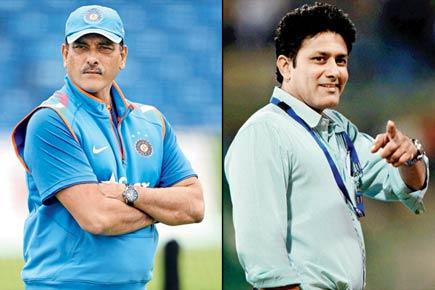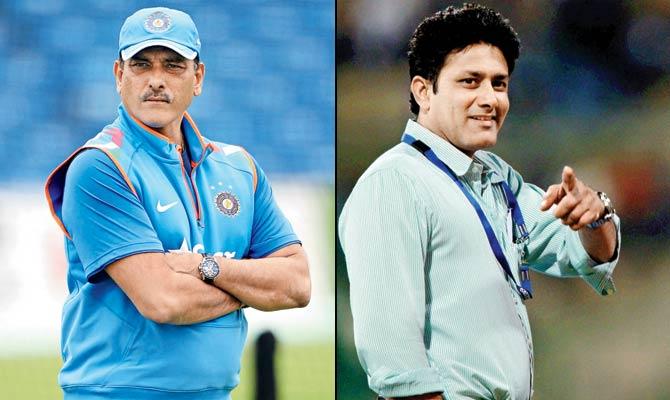If Sourav Ganguly’s Cricket Association of Bengal meeting came in the way of him interviewing Ravi Shastri, wasn’t there a tomorrow?

 Cricket lived up to its reputation of being a game of eternal surprises last week. The selection of Anil Kumble as India’s head coach is another example. Although the gentlemanly Kumble will never view it like this, it was a come-from-behind victory for the Bangalorean. That’s not to say he doesn’t merit it on the basis of his credentials.
Cricket lived up to its reputation of being a game of eternal surprises last week. The selection of Anil Kumble as India’s head coach is another example. Although the gentlemanly Kumble will never view it like this, it was a come-from-behind victory for the Bangalorean. That’s not to say he doesn’t merit it on the basis of his credentials.
ADVERTISEMENT
Truth be told, Shastri deserved the job as well. He took over in a crisis after a 1-3 Test defeat to England in 2014 and delivered to a good extent, only to find himself beaten in the last session. He didn’t give the impression of craving for the job. Nor did he allow the fear of not getting the post come in the way of expressing an opinion. A lesser man would have been diplomatic when asked about the Dhoni-Kohli captaincy issue, but without being disrespectful to either of them, he spoke out.
 While Ravi Shastri was considered a favourite, Anil Kumble got the job
While Ravi Shastri was considered a favourite, Anil Kumble got the job
Several theories did the rounds — Sourav Ganguly, a member of the three-man selection committee conspired to get Kumble in; politics played its part and, most recently, Shastri didn’t get the job because he never got along with Ganguly.
But let’s examine the facts: Kumble may have been talked into applying, but he did it before the June 10 deadline. Shastri was linked up via Skype. Sachin Tendulkar was linked up too. Ganguly was not present when Shastri was interviewed and the interactions took place only on one day. Firstly, why should such an important exercise be done via video conference? Ideally, all parties concerned ought to have been there in person and if that was an impossibility, what was the big hurry to finish it in one day? The BCCI laid down the criteria of candidates having coached a domestic team or country. If they ended up picking Kumble who didn’t meet these requirements, why did they set the rules in the first place?
The president and secretary spoke about how transparent the selection process was at a press conference in Dharamsala last Thursday. The media present lapped it all up. A few days later, we learn that Ganguly was not present when Shastri turned up on the screen. He was at a book release function, a report said. Another story stated that he had to attend the Cricket Association of Bengal Working Committee meeting. It may have been a critical meeting, but the BCCI played an unfair umpire by calling off the match. This was not a Test match that had to end at a stipulated time. Yet, the BCCI says that the process was fair. One wonders what transparency they are talking about when the media was not even informed as to who are going to appear for the ‘selection’ meeting. On the day of the interviews, some reports said that Sandeep Patil, another contender, was in Kolkata too, along with Lalchand Rajput, Pravin Amre and Kumble. The truth is Patil was nowhere near Kolkata.
In the new BCCI regime that utilises the services of a media manager, releasing the names of those who were going to be interviewed would do justice to transparency. Or was it asking for too much?
While the selection committee was a credible one, it was tiny. Furthermore, it ought to have had an equal number of personalities who hadn’t played in the same era. This would probably have facilitated another view in a healthy discussion and that is what is needed in such a critical appointment. For example, there could have been an opinion which centred around having a low-profile coach who had the experience of handling an international team. Not that Kumble is going to put himself in the forefront — that’s never been his style — but someone whose achievements and stature will be secondary to his functioning.
Another example of poor transparency was the announcement of the batting and fielding coach for the West Indies tour in a press release — minimal details that had no mention of whatever happened to the bowling coach before BCCI secretary Ajay Shirke told this newspaper that Kumble didn’t want a bowling coach.
On Tuesday, the BCCI announced the venues of the India vs New Zealand series and ended the press release by including the tweets of some members of the Indian team, who had already reacted to the schedule on social media. Why is it that news of greater significance isn’t accompanied by press releases that are equally exhaustive?
Communication is not BCCI’s favourite subject and other cricketing nations are outscoring them.
The handling of the coaches’ interviews was poor on some counts. It was as if the focus of attention wanted to shift from Kolkata (venue of the coaches’ meeting) to Dharamsala (venue of the BCCI Working Committee meeting) at the speed of light.
So here we are: An all-time great is appointed as coach to take Indian cricket forward, while two former captains are caught in a controversy about a coach selection process which was projected as fair but turned out to be messy.
Clearly, Indian cricket is very consistent on one aspect: Drama.
mid-day’s group sports editor Clayton Murzello is a purist with an open stance. He tweets @ClaytonMurzello. Send your feedback to mailbag@mid-day.com
 Subscribe today by clicking the link and stay updated with the latest news!" Click here!
Subscribe today by clicking the link and stay updated with the latest news!" Click here!






